Suspension systems are the backbone of vehicle comfort, safety, and handling. Over more than a century, they’ve transformed from rudimentary leaf springs to smart, adaptive systems that react in real-time. Here’s a deep dive into that journey — how each step forward revolutionized ride quality, control, and innovation on the road.

Early Suspension Designs (1880s–1930s)
The first automobiles borrowed suspension directly from horse-drawn carriages: leaf springs. These were stacks of curved metal strips designed to absorb bumps.
Pros:
-
Simple and durable
-
Able to handle heavy loads
Cons:
-
Heavy and inflexible
-
Poor ride comfort
-
Limited damping control
From the 1920s, coil springs gradually replaced leaf springs in lighter vehicles. They offered smoother rides and better packaging, improving comfort and handling.
Mid-Century Advances: Hydraulics & Structural Changes (1940s–1970s)
As cars got faster and roads improved, coil-spring suspensions were paired with hydraulic shock absorbers. These oil-filled dampers controlled spring oscillations, boosting stability and passenger comfort.
The period also introduced independent suspension, with setups like MacPherson struts in the front and semi-trailing arms in the rear.
| Innovation | Benefit | Typical Use |
|---|---|---|
| Hydraulic shocks | Damping and ride control | Most passenger cars |
| MacPherson front struts | Compact and cost-effective | Front-wheel-drive cars |
| Independent rear suspension | Better tire contact, comfort | Mid- to high-end models |
Air & Torsion: Ride Height & Weight Control (1960s–1990s)
As luxury comfort became important, torsion-bar suspensions appeared — especially on trucks and off-road vehicles. They offered ride height adjustability and simplicity.
Air suspension emerged in the 1970s, using pressurized air bags instead of metal coils. It provided:
-
Adjustable ride height
-
Smoother rides at design loads
-
Dynamic comfort tuning
However, complexity and high maintenance costs limited widespread use.
The Rise of Smart & Adaptive Systems (1990s–2010s)
Electronics revolutionized suspension systems, allowing reactive and intelligent setups:
-
Adaptive dampers: Electronically-adjusted hydraulic valves tuned damping in milliseconds based on road speed, steering input, and driver mode.
-
Self-leveling air suspension: Maintained optimal vehicle height regardless of load.
These systems delivered dynamic benefits:
-
“Comfort” modes for luxury cruising
-
“Sport” modes for tight handling
-
Off‑road/tow modes for load control
Examples: Audi’s Air Suspension, BMW’s Dynamic Damper Control, Mercedes AIRMATIC.
Modern Era: Electromechanical & Electromagnetic Suspension (2010s–Now)
The latest frontier enables active and predictive suspension:
Electromagnetic Systems (e.g., Magneto‑Rheological Dampers)
-
Use magnetic fluid whose viscosity changes under an electromagnetic field
-
Adjust damping in milliseconds
-
Examples: GM’s Magnetic Ride Control™, Audi’s Magnetic Ride
Electromechanical Suspension
-
Use electric actuators to compress or extend suspension per wheel
-
Provide roll control, ride-height, even road-surface compensation
-
Example: Mercedes-Benz E-Active Body Control on S-Class
Comparative Overview
Here’s a streamlined history of suspension evolution:
| Era | Technology | Key Benefit | Vehicle Type |
|---|---|---|---|
| Pre‑1930s | Leaf / coil springs | Load support, basic comfort | Early cars, trucks |
| 1940s–1970s | Hydraulic shocks, independent susp. | Improved damping, handling | Everyday sedans, pickup trucks |
| 1960s–1990s | Air & torsion suspensions | Height control, luxury ride | SUVs, luxury cars |
| 1990s–2010s | Adaptive / self-leveling susp. | Mode-based ride tuning | Premium, performance vehicles |
| 2010s onwards | Magneto‑rheological, active susp. | Ultra-fast, predictive control | High-end luxury & EVs |
Why This Progress Matters
These suspension advancements offer real-world, tangible benefits:
-
Safer driving: Better tire contact and stability
-
Enhanced comfort: Softer ride over rough roads
-
Versatility: One vehicle, multiple driving modes
-
Weight savings: Especially with composite springs & air systems
-
Advanced capabilities: Roll control, ride height, terrain adaptation
Considerations for Vehicle Owners
Whether classic or modern, keep these in mind:
-
Old systems: Leaf springs and basic shock setups still serve but may feel rigid
-
Adaptive/air systems: Require more maintenance — check air compressors, fluid, sensors
-
Electromagnetic/active setups: Provide elite performance but often costlier to repair
Need to Upgrade or Replace Your Suspension?

Whether you drive a compact car, SUV, or performance vehicle, maintaining your suspension is essential. Over time, springs, struts, and dampers wear out — leading to poor handling and comfort.
Looking to restore or improve your ride?
This store offers a wide range of rear suspension parts: shocks, springs, control arms, and complete kits — organized by vehicle compatibility. Whether you’re replacing worn parts or upgrading for performance, you’ll find exactly what you need.
Final Thoughts
Suspension systems have come a long way — from basic leaf springs to predictive AI-driven systems. Each step in their evolution has aimed to improve one thing: the way we experience driving.
Understanding the past helps you make smarter choices today, whether you’re servicing an older vehicle or upgrading your modern one.
Ready to enhance your ride?
Buy Suspension online and choose components that keep you comfortable, confident, and in control — wherever the road takes you.